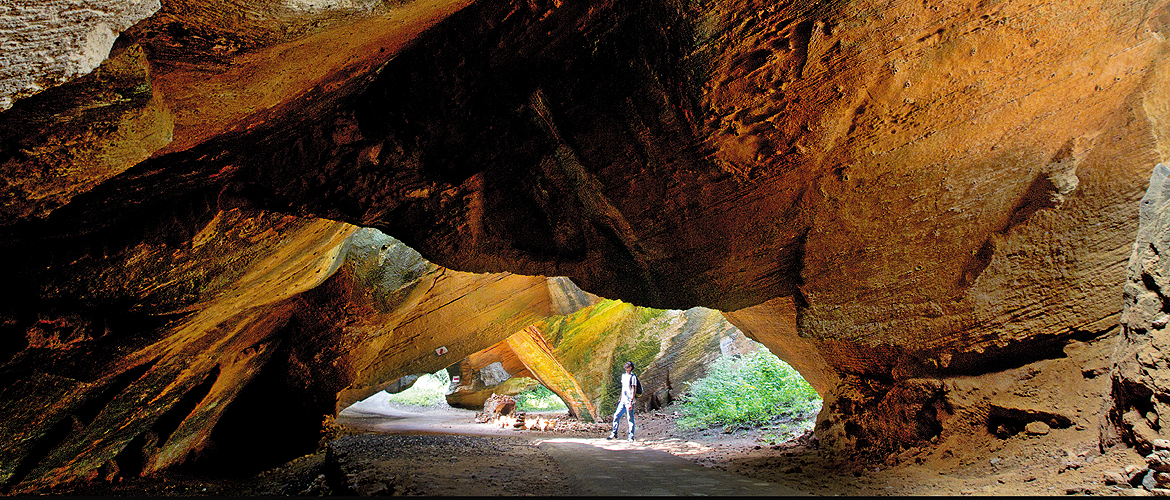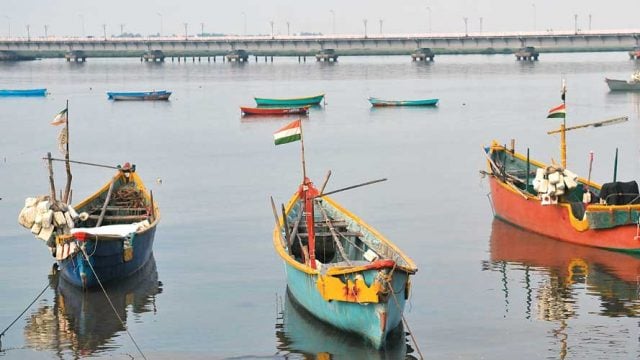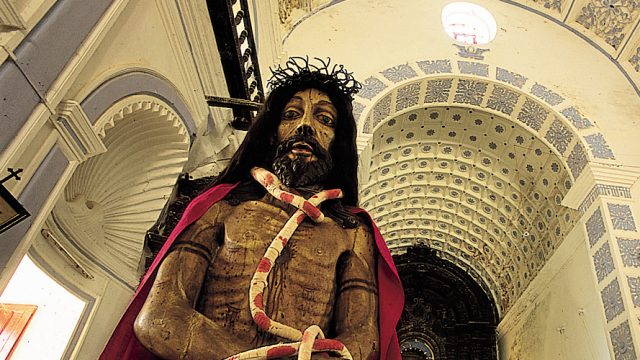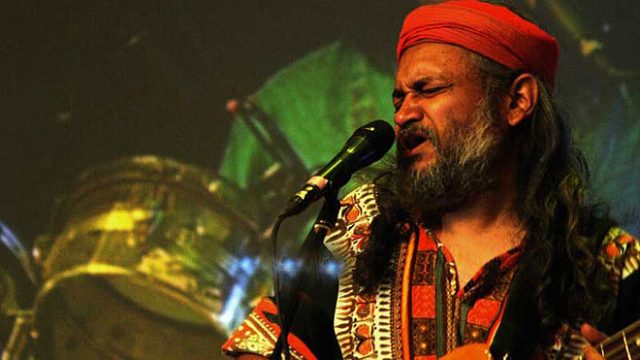In early 2015, Diu tourism launched an ad that branded the small island at the southern tip
Mornings in Diu are indeed eerily quiet. The view from the first-floor balcony of our guesthouse is a window to the island’s skyline. Amidst the many short, multi-coloured Gujarati homes, three prominent churches stand tall with their crosses and bell towers. Near the coast, Hoka trees, also called ‘doum palm’, quietly watch over the stirring morning. This peculiar tree looks like a bunch of dudes with the same perm joined at the hip, and bears an eccentric red fruit with a hard skin and an even harder seed. Our guide at the Diu fort, Valjibhai Solanki, boasts that even a fully loaded truck couldn’t crush the seed and that the locals use it as firewood. Local legend dictates that the tree, said to be indigenous to southern Egypt, was brought by the Portuguese. Baskets full of hoka, or ‘gingerbread fruit’, were discovered in King Tutankhamun’s tomb in 2007.

We spend our first day visiting the famed churches. You can immediately tell that the heritage left here must have looked majestic in its prime. But the current appearance speaks of indifference. While St Paul’s Church, built in 1610, has maintained its elaborate baroque marble façade and holds a mass every day, the other churches don’t enjoy the same fate. A part of the church of St. Francis of Assisi, built in 1593, functioned as a government hospital for years, but is now enveloped in scaffolding. Locals say it is being converted into a museum. While that may sound like a good plan, the church of St. Thomas built in 1598 is an example of how wrong that can go. The wall paint has peeled off; it houses wooden sculptures of saints which are declared 400-years-old by a plaque outside. The sculptures are covered in dust and lit by hideous LEDs. A search for their origins draws a blank as the guards and the caretaker just repeat the words on the plaque. The caretaker’s work is to restrict tourists from taking photographs of the relics. The museum though is still in a better state than the church of Our Lady of Remedies in Fudam, which is now populated only by thriving pigeon families.
We spend an overcast second day exploring the Diu fort, replete with its cannons, bastions and a moat that was built to feed off sea water during high tide. Our guide, Solanki, is an old man with hands burned in a stove accident years ago. One of the three government-approved guides at the fort, he gives us an account of the wars fought and won by the Portuguese here, and the day in 1961 when they lost Diu to India. Interestingly, some prison cells are still functional inside the fort and they now house local criminals for petty crimes.
Most of the restaurants in the city serve Gujarati, Punjabi and Chinese food of average quality. The main attraction here remains cheap alcohol in dimly-lit bars and the weekends witness a rush of tourists from the neighbouring dry state of Gujarat. Diu’s local culinary specialties hide in the most inconspicuous of places. O’ Coqueiro (The Coconut Palm) behind Diu museum is one such lucky find. The owner, Kailash Pandey, having learned recipes from a now-deceased local, has a scrumptious ‘Portuguese Comida’ section on the menu. We’ve finally found a place for our meals!

Our third morning is blessed with ample sunshine. So we head out to Naida caves, a network of hewn hollows located just outside the Diu city wall. Said to have been carved out by the Portuguese as they dug for building materials, these ‘caves’ have a mysterious aura accentuated by gigantic banyan tree roots and early morning sunrays that lend a golden hue and cast spotlights on the rocky site.
While the cross-marked sites on the Diu tourism map make for a mixed bag of experiences, some unexplored sites can be pleasant surprises. We’re beach hopping on the third day when we come across a bunch of fishermen on Gomtimata beach fashioning a fishing net out of nylon rope. Nearby, seagulls are busy fishing with their natural tools. In the distance, a green hillock by the shore is dotted with colourful huts. One of the fishermen, Lakhabhai, tells us that it is a memorial built for 140-odd fishermen who died at sea during the 1998 cyclone. We decide to pay a visit.
A barely noticeable right turn on the highway from Gomtimata to Nagoa ends in a clearing – on the left, the green hillock rises seductively, on the right the Gomtimata beach begins to take stride. What looked like huts are actually miniature structures that resemble the city’s Gujarati houses. On the outside, most have inscriptions of names of the deceased along with the dates of their death. While this memorial started off as one for the cyclone casualties, it has now come to commemorate any death at sea and even others that happen in the town. Each hut has stones inlaid with sacred threads tied around them. Incense stick aroma hangs in the air; the rusted iron gates remain open. Walking amidst the tiny huts is akin to being in a graveyard, except the dead aren’t buried here. They’re still out at sea.
After having a somber lunch, we head to the one Diu attraction that every review seems to be ambivalent about—the Shell Museum. Located near the airport on the roadside, it’s a blink-and-miss site—a modest, green structure that looks more like a garage. Much to our chagrin, the shutter is closed. The front yard is littered with hoardings declaring, in wretched English, the 5,000-odd types of shells to be the property of Capt. Devjibhai Fulbaria. In a few minutes, an old man clad in boxers and a vest arrives on a bicycle, a satchel hung on his back. It’s made of nylon net and contains three freshly caught fish. He pulls up the iron shutter and ushers us in. Inside is an overwhelming collection of shells of all sizes, star fish, crabs, flying fish, octopuses dried to a wreck, clams and even barnacles on manmade items.
The caretaker, however, is anxious about the power being consumed by the lights and fans due to our visit. When we inquire about the owner of this fascinating collection, he looks perplexed. “Why it’s me, of course!” And the stooping old man pulls out an old merchant navy cap and puts it on—a shadow of the man in the signboards manifests. Captain Fulbaria is full of stories. But he chooses to focus on the ones of the exams he failed in the merchant navy because of poor English. (Now the signboards make sense.) He says he served from 1959 to 1995, the last five years as captain. On his journeys in international waters, he collected everything that intrigued him. As we exit, the captain hands me two beautiful shells and switches off the lights hurriedly.

On our last day, after a short walk amidst ancient Gujarati havelis in the old city, we head out towards the Diu fort again, this time to witness the sunset from a vantage point we had noticed from the fort. The coastline near the fort is made of jagged rock cliffs. Standing atop the final land frontier, I witness the perpetual erosion that the waves have used to carve out caves beneath my pedestal. Egrets swoop down occasionally on the bed of yellow and purple wildflowers. Nearby, the ‘seven sisters’ are preening, quietly. Out here on the isle of calm, even the jungle babbler does not break the sanctity of silence.
The Information
Getting There
An Air India flight connects Diu to Mumbai four times a week (fares from ₹6,118). The nearest railway junction is Veraval (88km). A cab ride from Veraval to Diu will take 1.5hr and costs around ₹1,200. Alternatively, a taxi from Ahmedabad to Diu will take over seven hours and costs ₹3,000.
Where To Stay
We stayed at Herança Goesa, a family-run guesthouse. But you will need to pack everything you need, including soaps and towels. The USP of this place is its proximity to attractions such as the churches, the museum and the fort (Non-AC room starts from ₹1,000; 02875-253851). If you want a place near Nagoa beach, Hoka Island Villa offers comfortable rooms and good food at affordable prices. (₹3,250 for standard room doubles, taxes extra; resorthoka.com)
Where To Eat & Drink
O’ Coqueiro behind Diu museum is a cosy little ‘garden music restaurant’, set up in the front yard of Kailash Pandey’s house. Look for the Portuguese section on the menu.
The waterfront restaurant, Apna Foodland, has the best view of the shimmering water. The food, although diverse, is average at best.
What To See & Do
Don’t miss the Naida caves outside the city wall, but visit on a sunny day so that you can see the chiaroscuro at play. Enter the old city through the grand, brick-red Zampa gateway and take a walk through the narrow lanes. Every old house and Gujarati haveli is a delight for shutterbugs. Gangeshwar temple, in Fudam village, is a singular place of worship tucked inside a naturally formed cave, where five shivlingas—believed to be installed by the Pandavas—are washed by seawater that submerges the temple during high tide. Climb atop the roof of the Church of St Thomas for a panoramic eagle’s-eye view of the city.
Diu fort is a must-visit. The fortress of Panikota is a peculiar, ship-shaped structure one nautical mile off the shore which isn’t open to visitors during the monsoon. The popular Nagoa beach offers watersports including parasailing, banana boat rides and water-skiing.
Diu Fort
Diu Tourism
Gujarat





